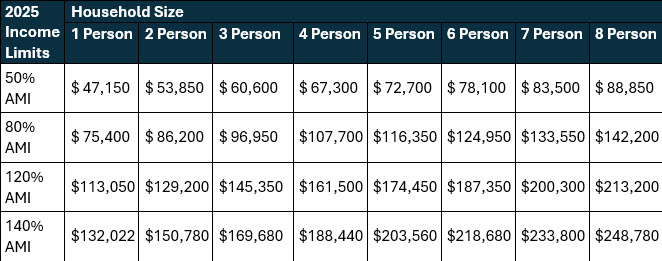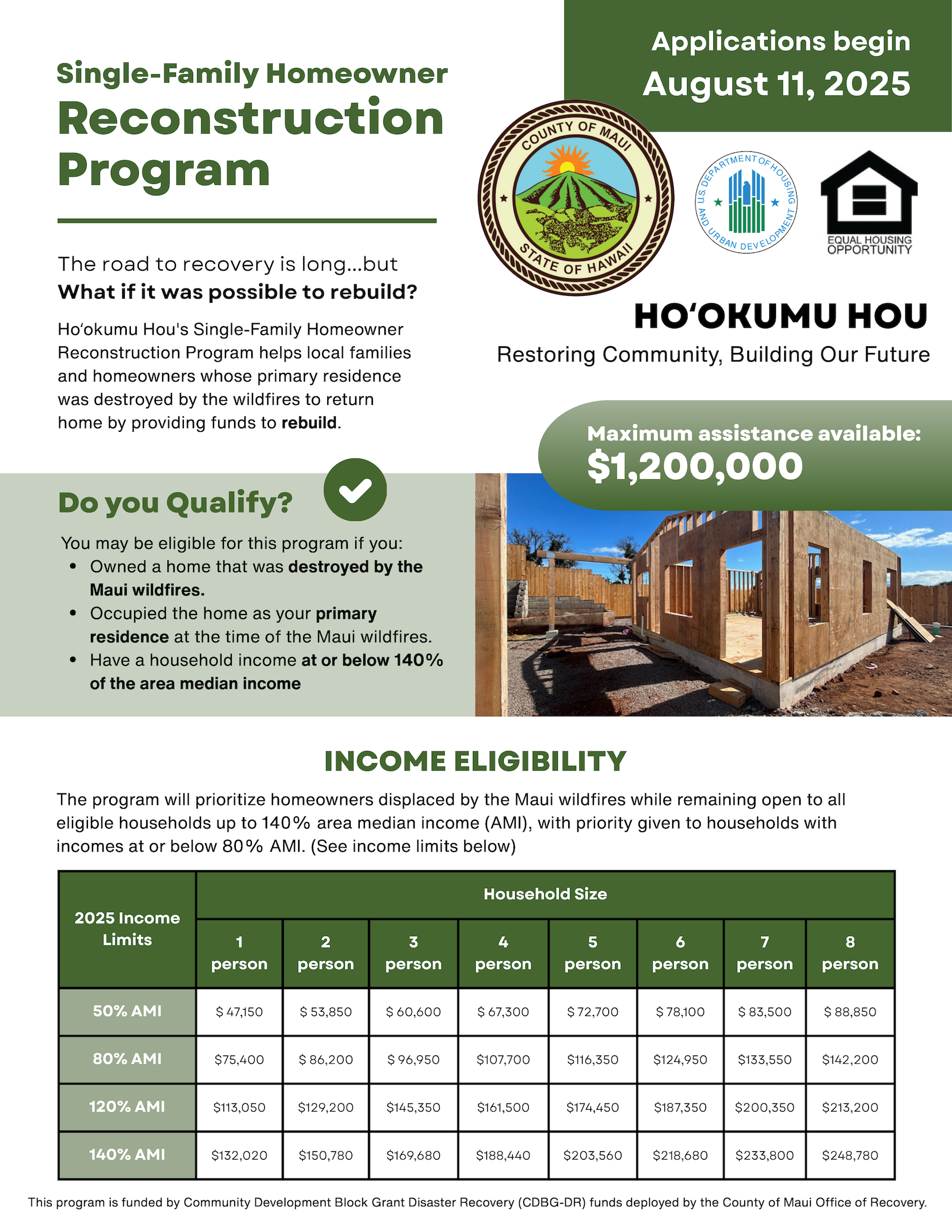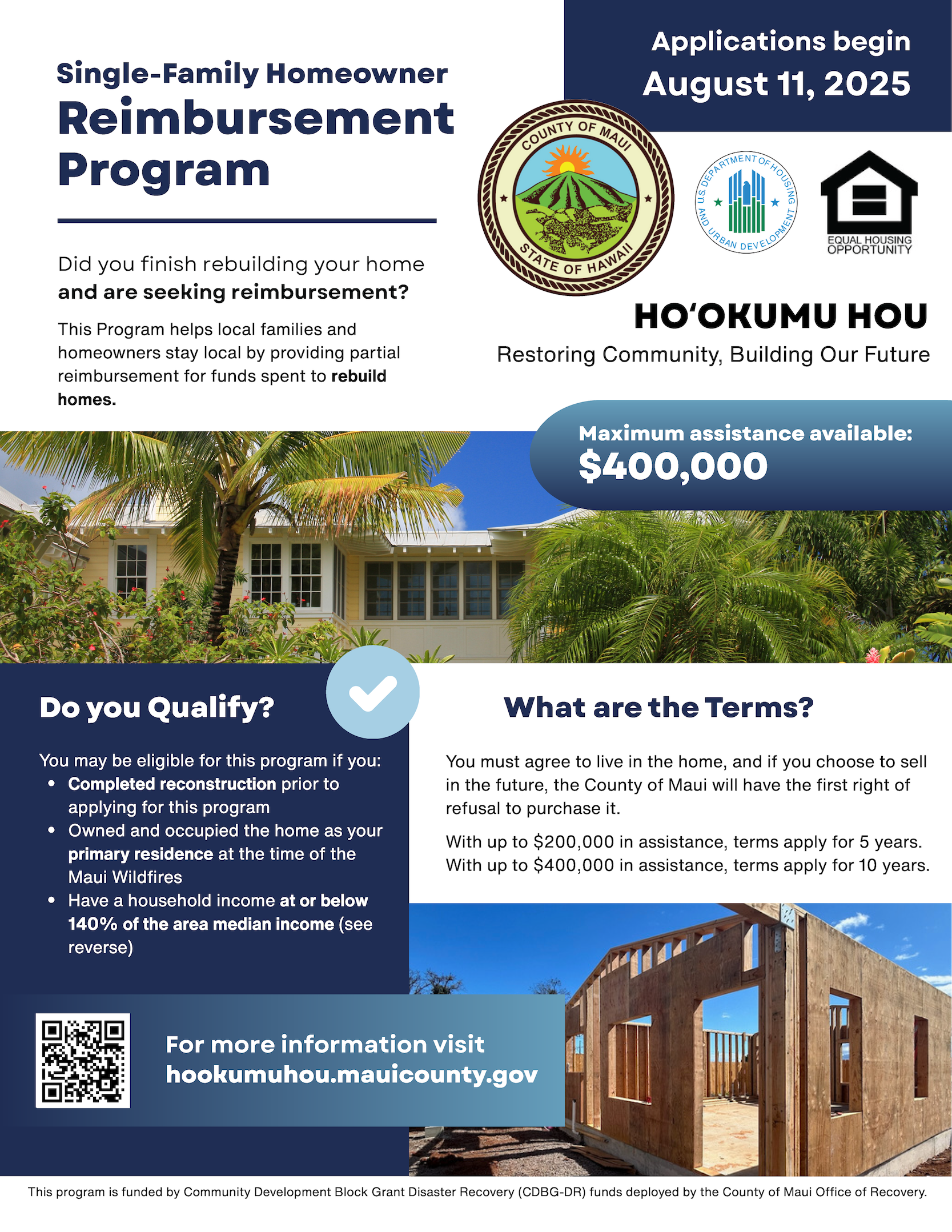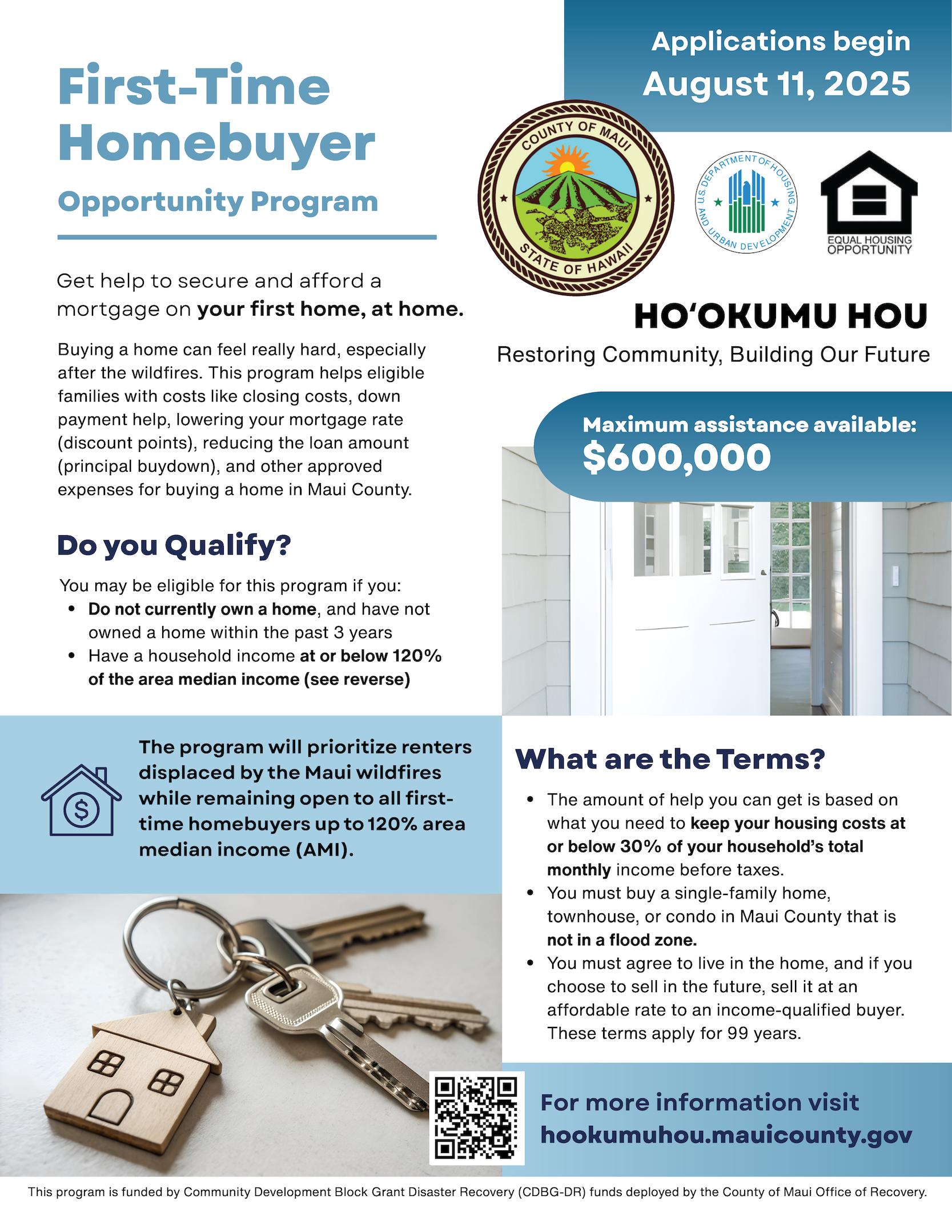To apply to the Ho‘okumu Hou programs and to learn more about the CDBG-DR-funded projects, visit hookumuhou.mauicounty.gov.
On Aug. 11, 2025, the County of Maui Office of Recovery began accepting applications for three Ho‘okumu Hou housing programs. Newly named Hoʻokumu Hou, which encompasses all of the County’s recovery programs funded by federal Community Development Block Grant Disaster Recovery (CDBG-DR) funds, focuses on housing initiatives intended to help wildfire survivors receive the means they need to stay, or return, home.
The following programs are currently open for application:
To apply for the programs and for more information, visit hookumuhou.mauicounty.gov.
For any questions, call (808) 865-4007 or email info@mauioor.com to reach staff dedicated to helping out residents through the application process.
For in-person:
The Office of Recovery hosted a series of community meetings on July 30 and Aug. 1, 2025, leading up to the opening of Ho‘okumu Hou program applications on Aug. 11. The Aug. 1 webinar consisted of three back-to-back presentations with Q&A, with approximately 1 hour dedicated to each program: the First-Time Homebuyer Opportunity Program, the Single-Family Homeowner Reconstruction Program, and the Single-Family Homeowner Reimbursement Program.
A follow-up webinar was held on Saturday, Aug. 9, 2025, during which finalized program policies were discussed.
The program will prioritize homeowners displaced by the Maui wildfires while remaining open to alleligible households up to 140% area median income (AMI), with priority given to households withincomes at or below 80% AMI. (See income limits below)
Area median income (AMI) is defined as the midpoint of a specific area’s income distribution and is calculated on an annual basis by the Department of Housing and Urban Development. Below is a chart showing the 2025 income limits by household size for Maui County.

To apply for the programs and for more information, visit hookumuhou.mauicounty.gov.
For any questions, call (808) 865-4007 or email info@mauioor.com to reach staff dedicated to helping out residents through the application process.
Community Development Block Grant Disaster Recovery (CDBG-DR) grant funds are appropriated by Congress and allocated by the U.S. Department of Housing and Urban Development (HUD) to rebuild disaster-impacted areas and provide crucial seed money to start the long-term recovery process.
Purpose of CDBG-DR funds:
For more information on CDBG-DR, visit : Community Development Block Grant Disaster Recovery Grant Funds | HUD.gov / U.S. Department of Housing and Urban Development (HUD)
The special appropriation provides funds to the most impacted and distressed areas for:
Each CDBG-DR activity must address a disaster-related impact (direct or indirect) in a Presidentially declared area for the covered disaster
*To meet a CDBG-DR national objective, all activities must:
CDBG-DR funds primarily benefit LMI (Low-To-Moderate Income) persons and communities, and other vulnerable members of the community who have been directly impacted by the disaster.
What is the household income limit to be considered LMI (Low-To-Moderate Income)?

Who is considered ''vulnerable''?
Broad Categories of Vulnerable Populations for CDBG-DR include:
If your household income exceeds the LMI limit you may not be eligible for the direct benefits provided by CDBG-DR funding. However, there could still be indirect benefits, such as improved infrastructure, community-wide recovery efforts, and other resources that support the overall resilience of the County. Additionally, the County may offer other programs or resources through different funding sources that may be more applicable to households above the LMI limit.
The CDBG-DR Action Plan outlines activities that the County will undertake under its recovery or mitigation program. Detailed funding amounts, sources of other funds, and implementation partners are included. Community input collected through the many community engagement events held by the County since the wildfires – including those that informed the County’s Long-Term Recovery Plan for Lahaina – have been incorporated into the draft, which was released and open for public review/feedback on Feb. 24, 2025. Public hearings on the draft Action Plan will be held on March 8, 11, and 14. The public comment period closes on March 26, 2025.
CDBG-DR funds are required to be used for programs that directly benefit individual survivors, such as rebuild assistance for eligible homeowners, and cannot be directly distributed to survivors.
CDBG-DR funds will be one of several funding sources utilized by projects in the County of Maui’s Long-Term Recovery Plan for Lahaina. For these funds, the County will consider all disaster recovery projects in the Long-Term Recovery Plan that are CDBG-DR eligible.
For questions, please contact the CDBG-DR Program Office at cdbg-dr@mauicounty.gov.






The County is in the process of creating a required draft Action Plan that will outline how the federal funds will be spent. That plan will be presented to the community for review and feedback in Spring 2025. The County will then make any necessary revisions to the draft and submit a final Action Plan to HUD for approval. Once HUD approves the Action Plan, funds will be released to the County and program implementation can begin.
After appropriation by Congress, HUD will calculate and announce allocations, and publish a Federal Register Notice, which describes the rules, procedures, waivers, and alternative requirements governing the CDBG-DR program.
Once the County is announced as a formal grantee and is provided an allocation amount, the County shall:

With Community input, engagement and comments, the County as the CDBG-DR Grantee will prepare a CDBG-DR Action Plan that will include eligible projects and estimated funding amounts for HUD’s approval.
The County’s Action Plan must include a Citizen Participation Plan which describes how the public will be informed and engaged throughout the grant’s lifecycle.
Prior to approval by HUD, the CDBG-DR Action Plan shall be posted for public comment to provide opportunities to citizens, affected local governments and other interested parties an opportunity to provide comments. All comments on the Action Plan or any substantial amendment, received orally or in writing, will be considered. Approved Action Plan and any amendments will be displayed on the County’s CDBG-DR webpage.
The County of Maui has developed a CDBG-DR Program Office, which is under the Office of Recovery in the Department of Management.
This office will be responsible for:
For more information, email cdbg-dr@mauicounty.gov.
For questions, please contact the CDBG-DR Program Office at cdbg-dr@mauicounty.gov.
The road to recovery is long...but what if it was possible to rebuild?
Ho‘okumu Hou's Single-Family Homeowner Reconstruction Program helps local families and homeowners whose primary residence was destroyed by the wildfires to return home by providing funds to rebuild.
Provide your comments on the draft Action Plan online, by mail or in-person at the Lahaina Resource Center or Kāko‘o Maui Relief & Aid Services Center.

Did you finish rebuilding your home and are seeking reimbursement?
This Program helps local families and homeowners stay local by providing partial reimbursement for funds spent to rebuild homes.
Provide your comments on the draft Action Plan online, by mail or in-person at the Lahaina Resource Center or Kāko‘o Maui Relief & Aid Services Center.

Get help to secure and afford a mortgage on your first home, at home.
Buying a home can feel really hard, especially after the wildfires. This program helps eligible families with costs like closing costs, downpayment help, lowering your mortgage rate(discount points), reducing the loan amount(principal buy down), and other approved expenses for buying a home in Maui County.
Provide your comments on the draft Action Plan online, by mail or in-person at the Lahaina Resource Center or Kāko‘o Maui Relief & Aid Services Center.

The County of Maui Community Development Block Grant Disaster Recovery (CDBG-DR) Action Plan was submitted to the U.S. Department of Housing and Urban Development on April 22, 2025 and approved on June 4, 2025.
Get NotifiedProvide your comments on the draft Action Plan online, by mail or in-person at the Lahaina Resource Center or Kāko‘o Maui Relief & Aid Services Center.

For Single-Family Homeowner Reconstruction Program
For Homeowner Reimbursement Program
First-time Homebuyer opportunity Program
Provide your comments on the draft Action Plan online, by mail or in-person at the Lahaina Resource Center or Kāko‘o Maui Relief & Aid Services Center.

Area median income (AMI) is defined as the midpoint of a specific area’s income distribution and is calculated on an annual basis by the Department of Housing and Urban Development. This chart shows the 2025 income limits by household size for Maui County.

For questions, please contact the CDBG-DR Program Office at cdbg-dr@mauicounty.gov.